With revolutionary smart building concepts, building automation over IP where Building automation and IT merge completely with IP-based system. The intelligent network reduces the interfaces between IT and building automation systems and requires no separate infrastructures. They utilise the existing local data network to ensure a high degree of convenience, productivity and security.
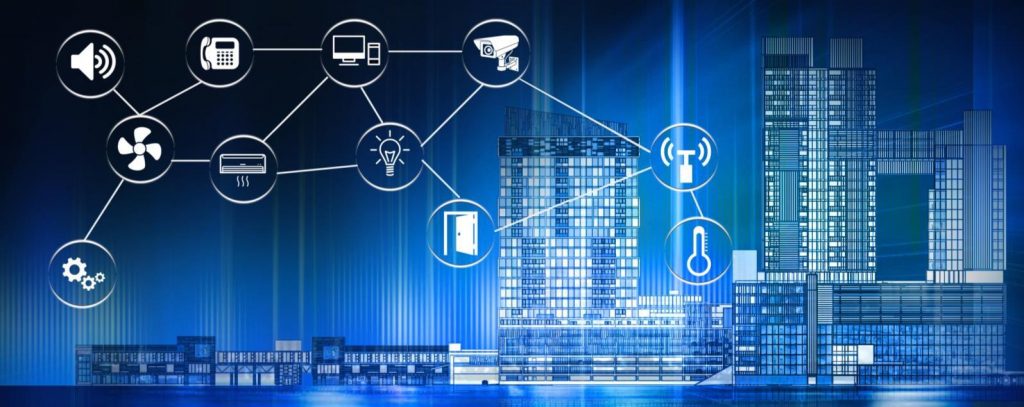
The smart building software forms a central integration point for all types of devices and services of a building automation system and perfectly maps the building infrastructure at building, floor or room level. The data prepared by the system form the basis for any decisions that may be necessary regarding resource consumption, adaptation of temperature, CO2 concentration or humidity, lighting as well as for predictive maintenance.
The core component of the smart building solutions is the smart application installed directly on the network switches in the rooms which communicate between sensors, actuators, and users. The environmental parameters measured are evaluated and the corresponding commands are sent to the responsible controller units and actuators. Standard functions are pre-installed and only need to be configured – adaptations are possible at any time. In addition, users can modify functions, such as lighting or air-conditioning, with the aid of a computer or mobile device on a room-by-room basis according to individual wishes. This raises the decentralised interaction of components of convenience and productivity.
Benefit:
Decentralised building automation over IP
Scalable architecture
Fail-safe network topology
Security through control software
Protection through IP security standards
Maximum security through authentication
SMART LIGHTING: LIGHT FROM THE NETWORK
As LEDs are progressively replacing conventional light sources in the workplace, particularly in modern office buildings in which special emphasis is placed on ergonomics, convenience and energy efficiency.
The intelligent functions promote productivity and well-being and further contribute to energy efficiency and unnecessary lighting costs for corridors or other services area devoid of people or deserted underground car parks are a thing of the past.
LEDs can be even more economic if they really only light up as needed and in an adapted intensity. Through the use of sensors, Smart Lighting allows lighting to always be deployed precisely where it is required. Individual luminaires can be controlled directly using network powered lighting controller and configurations of individual rooms can be adapted conveniently at the click of a mouse.
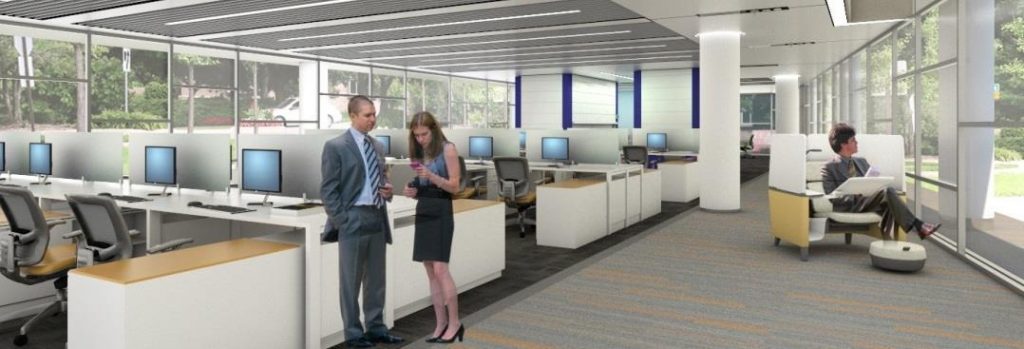
ADVANTAGES:
- Scalable room-by-room concept, requires no centralised planning or control
- Integration of lighting, shading, heating, air-conditioning, ventilation and public address in an interactive system, incl. control and monitoring
- Circadian Lights for employee wellbeing
- Optimisation of energy consumption including reduce operating & maintenance costs through anticipative identify cation of the service requirement
- LED control and dimming 0-100%
- Every light gets a sensor and software driven zones define per fixture control.
- Occupancy, Daylight harvesting, temperature at every sensor
- User defined Security alerts (email server configuration required)
- Historical data storage, Real time actual power consumption & Maintenance alarms for every fixture including mobile scene controllers.
- Energy Saving, Optimizing Operation & Maintenance,
- Enhancing efficiency & productivity including complying to Green building norms etc.
INSTALLATION OF PoE LIGHTING IN PLASSER INDIA, KARJAN
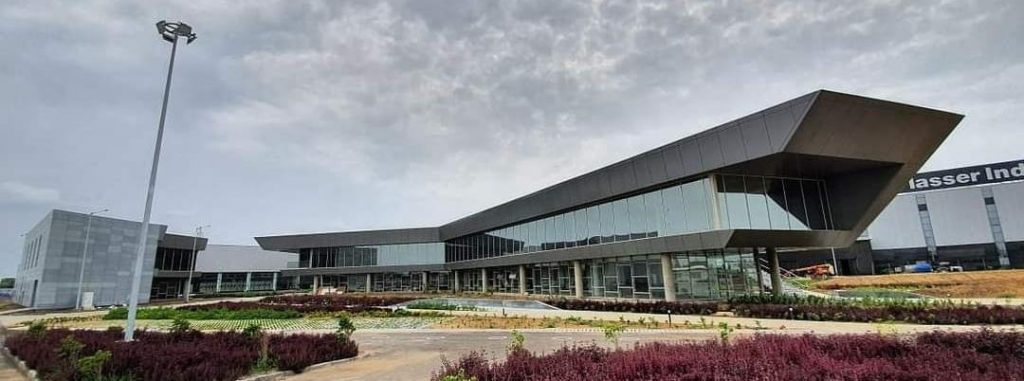
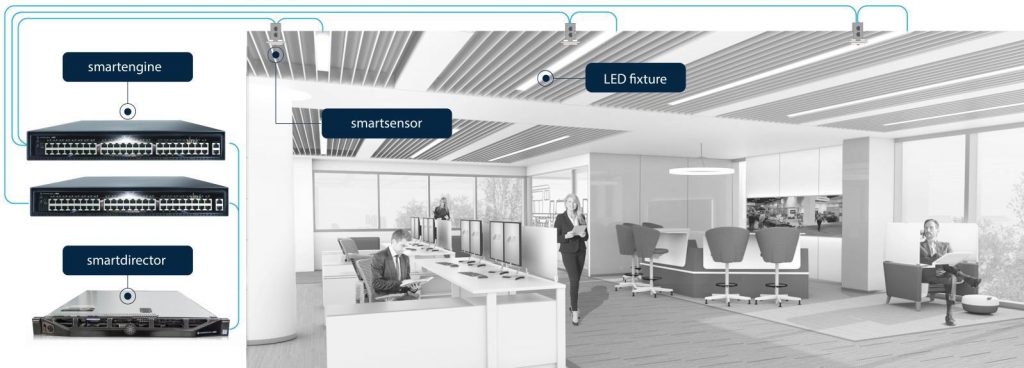
Lighting automation was the requirement for the building where controlling light was the priority of the client. ANA design planned to used PoE technology to automate the lighting considering the day light & occupancy are the prime input parameters for the control of light fixture including switching & dimming as required by client. Digital input of the occupancy status in any area of the admin building through the light sensor was provided to the Building management system to integrate the HVAC system. The data are available on an open API platform through which multiple logics can be created for the HVAC operations.
Instead of implementing a typical legacy analogue lighting controls of fixture, scalable reliable digital control operated over wired infrastructure through power over Ethernet (PoE) was implemented.
Challenges we faced on the design is placing the main HUB for the control of lighting. Solutions available in the industry include centralised and decentralised system. With all pro and cons for the building, centralised system was finalised & planned for the project of Plasser India Admin block considering the requisite limitation of the requirement of cable lengths.
The system has been commissioned in July 2020 and is running.
The Control & Monitoring over Energy consumptions, Health status of LEDs can be seen from common dashboard simplifying user experience further reduction in operation & maintenance costs.
The system can be easily configure without much engineering, adaptable to site changes from complex wiring system modification and hassle free commissioning (friendly addressing/ grouping) over two way communication which create a perfect solution for the user .

Our suggested application area for PoE Lighting
- Indoor workspace
- IT/ITES, BPO/KPO
- Hospitals, Hotels
- Smart Building
- Smart Industries
- Large Campus



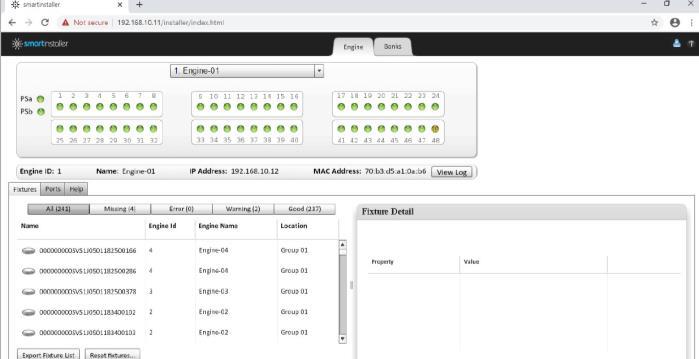




First of all thanks a lot to share this much knowledgeable write-up. In fact, energy automation is connected with operations and maintenance. Even minor changes in operations or maintenance can have a significant impact on building performance. For any energy management program to be successful, effective operations and maintenance systems are essential. This strategy can also be used to implement an energy management program.
Thankyou! Glad you liked it! Great insight!
I Really Could Use These Tips . Their Great
Smart Engineering Design
Thankyou! Glad we could help!
Nice blog!
Thanks for sharing this informative blog
Its primary purpose is to confirm the learner’s occupational competence as a construction operative. As a work-related, competence-based qualification it provides confirmation to employers, industry managers and card schemes that the learner has the skills and knowledge needed to meet the nationally recognised standard to carry out the role.
Thankyou! Great insight!
Thanks for the articles. Surfaces reporter magazine is one of the best architecture and interior design magazine in India. kindly Subscribe. More detail please visit our website. https://www.surfacesreporter.com/.
Thankyou! Will surely check it out!
It really interests me to read such articles, thanks for sharing. Blogs like yours really helps me learn more day by day.
https://tsca.com.ph/
tscaelectricalgroupcompany@gmail.com
Thankyou! Glad you liked it! Stay tuned for more!
Thankyou this is helpful. best licensed builders lahore pakistan
Great designs. Thanks for Sharing
Thanks for sharing the informative Blog
This blog is really informative and enlightening. It reminded me of viAct AI EHS Software powered with AI video analytics which gives the ability to monitor construction projects in real-time, identify and resolve issues quickly, and improve communication between team members. Construction Project Management software is essential as it helps to identify potential hazards, track project progress, and verify that work is being completed according to the project schedule. To improve safety and efficiency at project sites, construction management software is a must.
Thanks for sharing such a great information.. It really helpful to me..I always search to read the quality content and finally i found this in you post. keep it up!
Thank you for sharing the best publications that are very useful to us. You made a good site and gave us such excellent information on this subject that is very interesting.
The article beautifully highlights how this technology is set to revolutionize our living and working spaces. Thanks for sharing.
In the rapidly evolving landscape of building automation, the future holds boundless possibilities. From advanced energy-efficient systems to smart sensor technologies, the future of building automation promises unprecedented efficiency and sustainability. Embracing innovative solutions and cutting-edge AI, the future buildings will be seamlessly integrated, offering unparalleled comfort and environmental consciousness. Stay tuned for an exciting era where buildings truly come alive with intelligence and purpose!